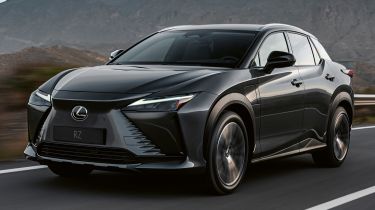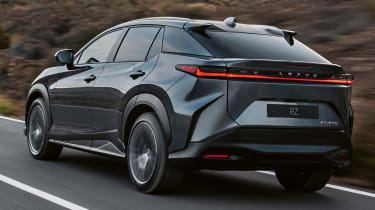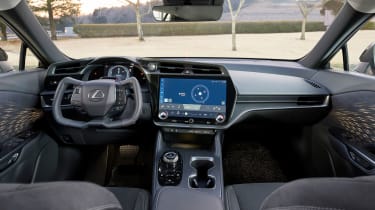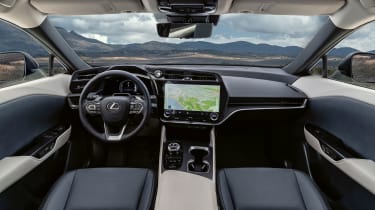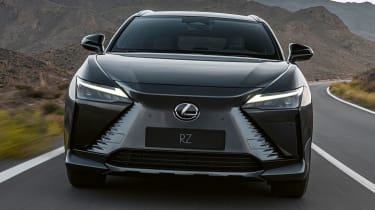Lexus RZ 450e: prices, specs and prototype drive
Lexus’ first-ever ground-up electric SUV is available to reserve now, coming with a ‘yoke’ steering wheel in certain markets
- Up to 271 miles of range
- Optional ‘yoke’ steering wheel
- Available to reserve now from £62,600
Pricing for Lexus’ first-ever ground-up EV, the Lexus RZ 450e, has been revealed, with the entry-level Premium model starting from £62,600. This new SUV sits parallel to the full-size Lexus RX SUV in the brand’s range and shares many of its parts with the Toyota bZ4X and Subaru Solterra.
 Top 10 best electric SUVs – the ones to buy in 2025
Top 10 best electric SUVs – the ones to buy in 2025
With a base price in excess of over £60,000, the RZ is much more expensive than the models on which it’s based. However, Lexus is hoping it will win people over with a plusher interior, targeting buyers of other premium electric SUVs such as the Audi Q4 e-tron and BMW iX3.
2022 Lexus RZ 450e: trim levels and specifications
Buyers can make a reservation to be first in line for the new Lexus RZ 450e now, and while there’s only one powertrain available at launch, there are three trim levels to choose from: Premium, Premium+ and the range-topping Takumi.
Starting at £62,600, you’d expect the entry-level Premium model to live up to its name – and it does, with a generous amount of standard equipment. All cars get LED headlights, a powered bootlid, leather upholstery, heated front seats, dual-zone climate control and Lexus’ latest 14-inch touchscreen infotainment system. Premium cars also benefit from 18-inch alloy wheels, which can be upgraded to 20-inch wheels for an extra £950.
Next up is the Premium+ model, which demands a hefty £4,000 extra over the standard Premium car. This extra cash nets you a head-up display, memory front seats, a 360-degree camera system and the aforementioned 20-inch alloys.
Starting at £72,100, the RZ 450e Takumi model is likely to be somewhat of a unicorn on UK roads, due to its high price. Befitting of its range-topping status, this model boasts several luxuries such as an upgraded exterior and interior lighting system, self-parking, a Mark Levinson stereo and adaptive suspension for a more comfortable ride. Premium+ and Takumi models can also be specified with distinctive bi-tone paintwork for £1,100 extra.
Design
In contrast with its rather convoluted name, the exterior of the new RZ 450e is much simpler than Lexus’ combustion-engined models. In place of the brand's trademark ‘spindle’ grille, the RZ instead gets a similarly shaped trim piece to aid aerodynamics. This is flanked by subtle vents which channel air through the wheel arches in order to further boost efficiency.
Speaking of the wheel arches, these are enhanced by plastic cladding in order to give off a more rugged appearance. At the rear, the RZ gets a sloping roofline and small ‘winglets’ in order to make the car as slippery through the air as possible. There is also a full width light bar, which is similar to the one used on the smaller Lexus NX crossover.
Elsewhere, the Lexus RZ 450e utilises a gloss black panel on the C-pillar to create the illusion that the roof is floating. Entry-level models sit on a set of 18-inch alloy wheels, while higher-spec cars feature 20-inch alloys.
Interior and technology
German rivals have historically had the edge over Lexus in terms of technology, but the new Lexus RZ 450e gets the brand’s latest infotainment system which ditches the old touchpad setup in favour of a slick 14-inch touchscreen. This boasts digitised, physical climate controls and is supplemented by a fully-digital instrument cluster for the driver.
Perhaps the most striking feature of the RZ’s interior is the optional ‘yoke’ steering wheel. Similar to that found in the latest-generation Tesla Model X, this butterfly-shaped wheel offers a more driver-focused experience and comes as part of the ONE MOTION GRIP system. This steer-by-wire setup allows for sharper turns at lower speeds with minimal steering input – only a 150-degree turn of the wheel is needed to go from straight to full lock – as well as offering more precise steering at high speeds. At this stage, it’s unknown whether this will be offered in the UK – of course, if you prefer a more traditional steering wheel, a circular one would also be available without the drive-by-wire technology.
Elsewhere in the cabin, the RZ 450e also gets extensive ambient lighting and a dimmable panoramic sunroof that can block infra-red radiation. A novel addition are the ‘radiant’ heaters mounted at knee-level in front of the driver and passenger, which work in tandem with the sunroof to use recycled warmth to heat the interior, boosting efficiency by reducing the need for the traditional, electrically-powered heater.
Overall, the Lexus’ interior design is very similar to its mainstream sibling, the Toyota bZ4X, as well as the mechanically-identical Subaru Solterra. Thankfully, a smattering of sumptuous leathers and other premium materials should help justify the RZ’s inevitable price premium over those two cars.
Powertrain and range
As mentioned, the Lexus RZ 450e shares its underpinnings with the Toyota bZ4X. Just like the Toyota, the Lexus is powered by a dual-electric motor setup mated to a 71kWh battery. However, for the RZ the power is raised from 215bhp to 308bhp, which in combination with the four-wheel drive traction allows the car to accelerate from 0-62mph in a rapid 5.6 seconds.
Less impressive, however, is the RZ 450e’s range, which caps out at just 271 miles on entry-level Premium models – significantly less than the 310 miles offered by the cheaper Nissan Ariya. Higher-end cars get even less range, with new data showing top-end cars with 20-inch alloys returning only 252 miles on a single charge. This is despite the fact the RZ’s all-wheel-drive system can shut off the rear electric motor to save battery, alongside the presence of a selectable ‘Range’ driving mode that can take things a step further by limiting the car’s top speed and turning off the climate controls.
On a more positive note, 150kW rapid charging is standard across the Lexus RZ range, meaning a top up from 10-80% can take as little as 25 minutes when connected to a compatible public fast charger. Plugging-in at home via a 7kW wallbox will take significantly longer, though, with a full charge taking around 10 hours.
If relaxation is more of a concern than range, RZ drivers can make use of the extensive Lexus Safety System +. This includes adaptive cruise control, lane departure warning, automatic headlamp high beam and a pre-collision warning. The system is also bolstered by a driver fatigue sensor and an enhanced blind spot monitoring system, which can prevent passengers from opening the door into a passing cyclist or pedestrian.
Prototype drive
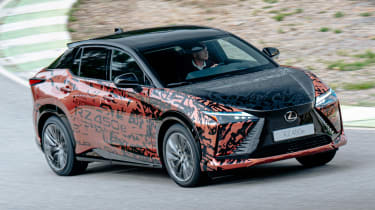
Electrification may seem like a relatively new concept for most manufacturers, but it has been an integral part of Lexus’s brand for decades. The Japanese marque launched its first hybrid, the RX 400h, in the late ’90s – at the time it was nothing less than a technological marvel.
In more recent years, the firm has continued to perfect its ‘Hybrid Drive’ technology, with ‘hybrid’ and ‘Lexus’ becoming somewhat synonymous with each other. However, with the recent introduction of fully-electric BEVs, the brand has been surprisingly slow at adopting this new technology… until now. Enter, the Lexus RZ 450e: the brand’s first ground-up electric car.
Taking a look at the RZ for the first time, you may squint and begin feeling a sense of deja vu. Your eyes are not deceiving you; the Lexus RZ is actually heavily based on the new Toyota bZ4X and shares many of its parts as well as an equally confusing name.
Nevertheless, the Lexus, on paper, appears like your run-of-the-mill electric SUV: it has a 71.4kWh battery, mated to two electric motors which provide a combined 309bhp and four-wheel drive. Lexus claims a range of 271 miles and a 0-62mph time of around five and a half seconds. It's quick, but all-in-all, pretty average for this class of car.
It appears, then, that Lexus may have lost its innovative streak and has just turned to building tarted-up Toyotas for those who fancy something different over the typical BMW or Mercedes. However, that predisposition quickly disappears as soon as you step into the driver’s seat because the RZ 450e could prove to be truly revolutionary behind the wheel – or should we say, yoke.
That’s right, the new Lexus RZ is giving buyers in certain markets the option of paying extra to ditch the traditional steering wheel and opt for a butterfly-shaped ‘yoke’, like something straight out of Top Gun. This is all because of Lexus’s new ‘One Motion Grip’ technology which eschews a traditional set-up for one that only connects the steering wheel to the front wheels via electric wires.
Dubbed ‘steer-by-wire’, this system utilises a variety of sensors to detect steering inputs and relays them through to a motor inside the steering rack which subsequently turns the wheels. Therefore, there is no need for a traditional steering wheel. So, how is it in practice?
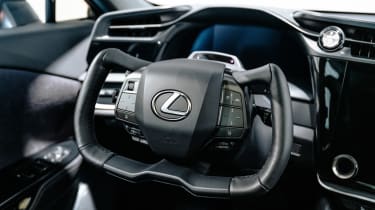
Our immediate impression was of the substantial feeling of the yoke; it takes more pressure to turn than you might expect. However we quickly got used to it after a few minutes.
The main advantage of this system is its ability to adapt the rate of steering depending on the situation. For example, at slower speeds it can reduce straight ahead to full lock to just a 150-degree turn, eliminating the need to cross your arms or take them off the yoke. This can be disconcerting at first, with the car changing direction much more quickly than you may expect. Nonetheless, we are sure that drivers spending more time in the car than we did will learn to adapt.
At higher speeds, the system does the opposite: each turn of the wheel feels more direct and precise. This, along with the RZ’s powerful electric powertrain, makes the two-tonne SUV feel much sportier than it has any right to be. Lexus tells us that this tech will end up finding its way into the brand’s sportier models, so a new version of the LC Coupe may be on the horizon.
We were only able to test the RZ on an enclosed track, but here we found the suspension to be as supple as any other Lexus model. The car does roll over road imperfections due to its hefty size, but overall the RZ is a comfortable car that should thrive on the bumpy roads of Britain.
For those who prefer a more traditional driving experience, Lexus will also offer the RZ with a standard steering set-up with a circular wheel. After driving around using the yoke, this almost felt archaic in comparison; it was certainly lighter, but having to turn the wheel at a greater angle just felt cumbersome. Lexus is yet to announce what the One Motion Grip system will cost, only stating that it will offer “value for money”, so we are unable to say at this stage whether it is truly worth the upgrade.
Elsewhere in the interior, Lexus has stepped up its game in terms of in-car technology because the RZ gets the same 14-inch infotainment touchscreen as the smaller NX. This is much more modern than the fiddly Lexus touchpad systems of old and comes packed with Apple CarPlay and Android Auto if you prefer to connect your phone. A “Hey, Lexus” voice command function also features, and thankfully, the climate controls remain as physical, yet digitised dials.
Verdict
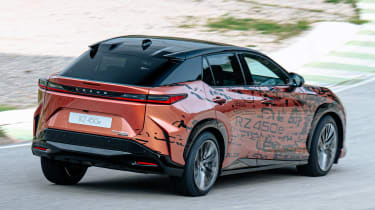
At face value, the Lexus RZ 450e seems like a relatively underwhelming attempt at an electric SUV from a manufacturer that is beginning to drop further and further behind German rivals. Thankfully, the RZ’s One Motion Grip system is just the kind of innovation this car and brand needs, and could well be the future for the way we drive. It’s just a shame that the Lexus can only manage 271 miles on a single charge, meaning it’s unlikely to provide any real competition to the likes of Audi, Jaguar and Tesla.
Need a cheap-to-run family car? Check out our list of the Top 10 best electric SUVs
Recommended

New Subaru Trailseeker revealed as rugged electric SUV with 375bhp

New Subaru Solterra brings more range, power and polish
Most Popular
Tips & advice

Car dashboard warning lights: what does each symbol mean?

Electric car charging stations: public networks, charger types, apps and maps


